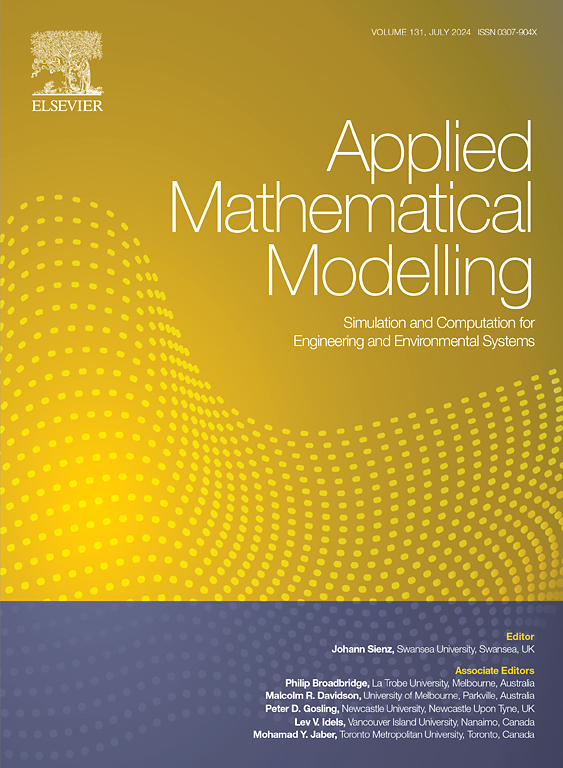Four-stage cascaded adaptive sliding mode control for automatic carrier landing with airwake disturbances and uncertainties
IF 4.4
2区 工程技术
Q1 ENGINEERING, MULTIDISCIPLINARY
引用次数: 0
Abstract
Objective
This paper addresses the carrier landing affected by airwake, parametric uncertainties, and carrier deck motion, its main target being the design of a novel sliding mode based automatic carrier landing system to obtain accurate tracking of the reference trajectory, robustness in terms of disturbances and uncertainties, as well as excellent touchdown accuracy.
Approach
For an aircraft nonlinear dynamics, written under a four-stage cascaded strict feedback form, the design of the novel landing control architecture involves the design of a guidance subsystem, robust sliding mode controllers (for the control of the heading angle, attitude angles, and angular rates), an approach power compensation system, adaptive control laws suppressing the uncertainties and disturbances, a Kalman filter for deck motion prediction, a block computing the reference trajectory, a tracking differentiator block for deck motion compensation, and first-order command filters.
Main results
The software validation process proves the effectiveness of the sliding mode based control scheme and the suppression of the uncertainties and disturbances. Also, the comparison between the performances of the sliding mode control based carrier landing system and the ones associated to other automatic carrier landing systems shows the superiority of the sliding mode based control scheme, as well as its better touchdown accuracy and landing success rate.
Significance
This study innovatively transforms the general carrier landing problem into a time-varying tracking control problem for cascaded strict feedback dynamics with disturbances and uncertainties. The new designed automatic carrier landing system is the first control architecture in the literature employing the sliding mode control augmented by adaptive control laws for carrier landing, subjected to airwake, deck motion, and uncertainties.
四级级联自适应滑模控制,用于具有空中摇晃干扰和不确定性的自动载机着陆
目的 本文针对受气流、参数不确定性和航母甲板运动影响的航母着陆问题,主要目标是设计一种基于滑动模式的新型航母自动着陆系统,以获得对参考轨迹的精确跟踪、对干扰和不确定性的鲁棒性以及出色的着陆精度。方法对于在四级级联严格反馈形式下编写的飞机非线性动力学,新型着陆控制结构的设计包括制导子系统、鲁棒性滑动模式控制器(用于控制航向角、姿态角和角速度)、进场功率补偿系统、抑制不确定性和干扰的自适应控制法则、用于甲板运动预测的卡尔曼滤波器、计算参考轨迹的模块、用于甲板运动补偿的跟踪微分器模块以及一阶指令滤波器。主要结果软件验证过程证明了基于滑动模式的控制方案以及抑制不确定性和干扰的有效性。此外,基于滑动模态控制的航母着陆系统与其他航母自动着陆系统的性能对比表明,基于滑动模态的控制方案具有更高的着陆精度和着陆成功率。新设计的航母自动着陆系统是文献中首个采用滑模控制和自适应控制法则的航母着陆控制架构,它受到了气浪、甲板运动和不确定性的影响。
本文章由计算机程序翻译,如有差异,请以英文原文为准。
求助全文
约1分钟内获得全文
求助全文
来源期刊

Applied Mathematical Modelling
数学-工程:综合
CiteScore
9.80
自引率
8.00%
发文量
508
审稿时长
43 days
期刊介绍:
Applied Mathematical Modelling focuses on research related to the mathematical modelling of engineering and environmental processes, manufacturing, and industrial systems. A significant emerging area of research activity involves multiphysics processes, and contributions in this area are particularly encouraged.
This influential publication covers a wide spectrum of subjects including heat transfer, fluid mechanics, CFD, and transport phenomena; solid mechanics and mechanics of metals; electromagnets and MHD; reliability modelling and system optimization; finite volume, finite element, and boundary element procedures; modelling of inventory, industrial, manufacturing and logistics systems for viable decision making; civil engineering systems and structures; mineral and energy resources; relevant software engineering issues associated with CAD and CAE; and materials and metallurgical engineering.
Applied Mathematical Modelling is primarily interested in papers developing increased insights into real-world problems through novel mathematical modelling, novel applications or a combination of these. Papers employing existing numerical techniques must demonstrate sufficient novelty in the solution of practical problems. Papers on fuzzy logic in decision-making or purely financial mathematics are normally not considered. Research on fractional differential equations, bifurcation, and numerical methods needs to include practical examples. Population dynamics must solve realistic scenarios. Papers in the area of logistics and business modelling should demonstrate meaningful managerial insight. Submissions with no real-world application will not be considered.
 求助内容:
求助内容: 应助结果提醒方式:
应助结果提醒方式:


